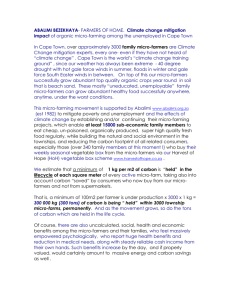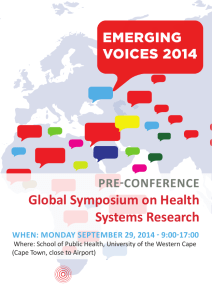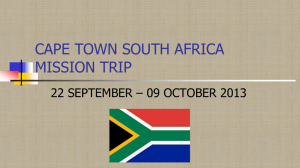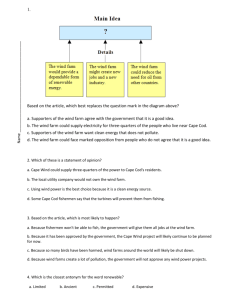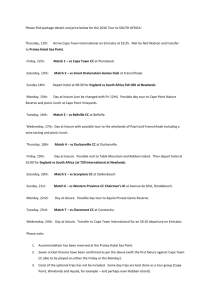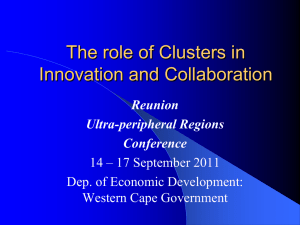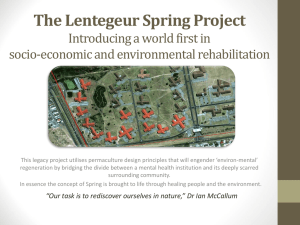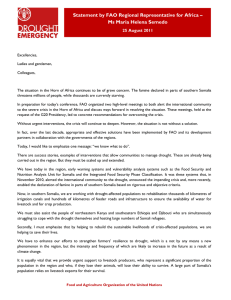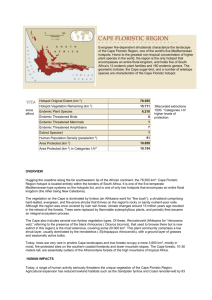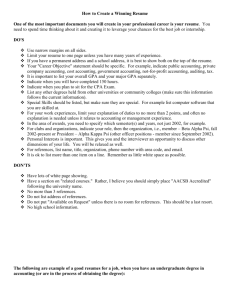September 2014 - Western Cape
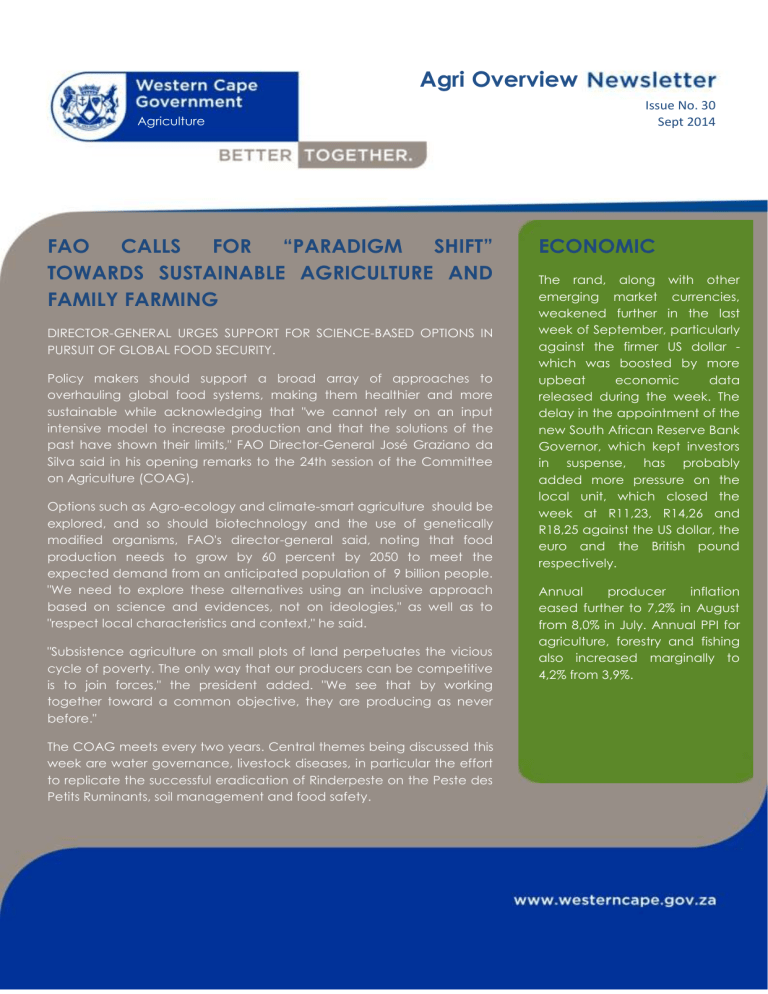
Agriculture
Agri Overview
Issue No. 30
Sept 2014
FAO CALLS FOR “PARADIGM SHIFT”
TOWARDS SUSTAINABLE AGRICULTURE AND
FAMILY FARMING
DIRECTOR-GENERAL URGES SUPPORT FOR SCIENCE-BASED OPTIONS IN
PURSUIT OF GLOBAL FOOD SECURITY.
Policy makers should support a broad array of approaches to overhauling global food systems, making them healthier and more sustainable while acknowledging that "we cannot rely on an input intensive model to increase production and that the solutions of the past have shown their limits," FAO Director-General José Graziano da
Silva said in his opening remarks to the 24th session of the Committee on Agriculture (COAG).
Options such as Agro-ecology and climate-smart agriculture should be explored, and so should biotechnology and the use of genetically modified organisms, FAO's director-general said, noting that food production needs to grow by 60 percent by 2050 to meet the expected demand from an anticipated population of 9 billion people.
"We need to explore these alternatives using an inclusive approach based on science and evidences, not on ideologies," as well as to
"respect local characteristics and context," he said.
"Subsistence agriculture on small plots of land perpetuates the vicious cycle of poverty. The only way that our producers can be competitive is to join forces," the president added. "We see that by working together toward a common objective, they are producing as never before."
The COAG meets every two years. Central themes being discussed this week are water governance, livestock diseases, in particular the effort to replicate the successful eradication of Rinderpeste on the Peste des
Petits Ruminants, soil management and food safety.
ECONOMIC
The rand, along with other emerging market currencies, weakened further in the last week of September, particularly against the firmer US dollar - which was boosted by more upbeat economic data released during the week. The delay in the appointment of the new South African Reserve Bank
Governor, which kept investors in suspense, has probably added more pressure on the local unit, which closed the week at R11,23, R14,26 and
R18,25 against the US dollar, the euro and the British pound respectively.
Annual producer inflation eased further to 7,2% in August from 8,0% in July. Annual PPI for agriculture, forestry and fishing also increased marginally to
4,2% from 3,9%.
MINISTER WINDE SETS
CHALLENGE TO WESTERN
CAPE AGRICULTURE
At the recent Land Reform
Summit hosted by the Western
Cape
Agriculture,
Department
Alan of
Winde,
Western Cape Minister of
Economic Opportunities, challenged the provincial agriculture sector to organise on a district level and devise plans to speed up land reform.
Winde gave the sector 3 months to establish district land reform committees, which will be responsible for identifying land reform opportunities in the immediate area.
The wide range of delegates in attendance at the summit discussed various models of land reform together with the support mechanisms needed in order to ensure sustainable and successful projects. The outputs of the summit will be taken further by the Department.
WEATHER
The Province received near normal rainfall but above normal in the far west. Winter cereal crops and pastures in
Bredasdorp and Caledon are normal, while less promising to the east due to below normal rainfall received. In Swartland livestock is in good condition while the grazing in
Matzikama is limited but livestock is in reasonable condition.
In the Central Karoo below normal rainfall resulted in insufficient water for livestock. The veld and dryland pastures are nearly depleted by livestock and crop production conditions are poor in Eden district.
Irrigated crops and pastures experienced good growth under increasing day light and temperatures. The level of dams is nearly similar to the previous year (92% in
2013; 91% in 2014).
Compiled by:
Jacques Murdoch
Telephone:
Email:
021 808 5197 jacquesm@elsenburg.com
DISCLAIMER
Although everything has been done to ensure the accuracy of this information,
Western Cape Department of Agriculture therefore accepts no liability that can be incurred resulting from the use of this information.
WHEAT
The expected commercial production of wheat is 1,791 mill. tons, which is 0,62% more than the previous forecast of 1,780 mill. tons, whilst the expected yield is
3,76 t/ha.
The expected production in the Western Cape is 914 500 tons (51%), in the Northern
Cape 285 000 tons (16%) and in the Free State 274
525 tons (15%).
The area estimate for wheat was revised to 476
570 ha, which is 8 570 ha more than the 468 000 ha of the previous estimate. The main reason for the increase in the area was because of an upward revision in the area planted for the Free State, from 60
000 ha to 69 500 ha.
The area planted in the
Eastern Cape was revised downwards by 1 000 ha to 3
000 ha and the area planted in Gauteng was adjusted upwards by 70 ha to 570 ha.
WOOL
The wool market maintained its recent gains and the Cape Wools
Merino indicator closed the day up by a marginal 0,6% at R114,68/kg (clean). This is
2,7% higher compared to the opening sale of this season and 2,0% up compared to the corresponding sale of the previous season.
Traders commented that the weaker rand had propped up the local market however in hard currency the market remained subdued due to poorer demand from
China. They described this week’s offering as small and of poor quality and expect next week’s selection to be similar.
TRACTOR AND COMBINE
SALES
August tractor sales of 582 units were almost 16% up on the 502 units reported in
August last year. Sales for the eight months year-to-date are now almost 5% down on the same period last year. August combine harvester sales of 25 units were significantly up on the 18 units sold in August last year. On a y-o-y basis combine harvester sales are now 4% down on the same period last year.
The good equipment sales in
August reflect the current optimism in the industry.
Nevertheless, with maize prices having fallen in recent months, industry expectations are still that the market in 2014 will be between 5 and 10% down on last year.
Sources:
FAO
StatsSA
Milk Producers Organisation
Grain SA
Department of Water Affairs
South African Reserve Bank
South African Agricultural Machinery Association and RGT SMART
CapeWools SA
Nedbank
Landbou Weekblad

